A Study on Establishing Thermal Output Conditions of Radiant Ceiling Heating Panels for Improving Thermal Comfort of Perimeter Zone in Buildings
Abstract
:1. Introduction
1.1. Background and Purpose
1.2. Scope and Method
2. Preliminary Study
2.1. Review of Preliminary Studies on Thermal Comfort Assessment of Radiant Ceiling Heating Panel
2.2. Parameters Affecting Thermal Comfort in Indoor and Outdoor Environments
2.3. Parameters for Assessing Thermal Comfort of Radiant Ceiling Heating Panel
2.4. Mechanism of Preventing Downdraft
3. Developing a Model for Evaluating the Thermal Comfort of Radiant Ceiling Heating Panel
3.1. Modeling Parameters for Evaluating the Thermal Comfort of Radiant Ceiling Heating Panel
3.2. Setting Simulation Conditions for Thermal Comfort Assessment
3.3. Numerical Model of Simulation
3.4. Simulation Cases
3.5. Validation of Simulation
4. Thermal Comfort Assessment of Radiant Ceiling Heating Panel in Perimeter Zone
4.1. Criteria of Thermal Comfort Assessment
4.2. Simulation Results
5. Establishing Thermal Output Conditions of Radiant Ceiling Heating Panel
5.1. Optimal Thermal Output Conditions for Radiant Ceiling Heating Panel Considering Thermal Comfort
5.2. Thermal Output Charts of Radiant Ceiling Heating Panel in Perimeter Zone
6. Conclusions
- (1)
- As the stringency of external environmental criteria was eased, the temperature difference between the interior surface of the window and the radiant ceiling heating panel surface decreased, resulting in a reduced draft rate in the occupied area with relatively smaller heat dissipation per unit area. This can be attributed to the fact that an increased temperature difference between the window surface and the panel’s heat dissipation surface raises the per unit area heat supply but also accelerates the speed of downward air currents. Consequently, relatively cooler air currents penetrate deeper into the occupied area.
- (2)
- Radiant asymmetry is not strictly a function of temperature alone; the area of the heat dissipation surface corresponding to the temperature also plays a significant role. Even if the radiant ceiling heating panels were operated at high temperatures, the heat dissipation area was not sufficiently large to induce discomfort due to radiant asymmetry. Therefore, discomfort resulting from high surface temperatures of the radiant ceiling heating panel did not occur.
- (3)
- In cases where radiant ceiling heating panels were applied without any internal heat generation, the draft rate at a point 1 m away from the window was approximately 20% when the external environment was in poor condition and about 10% when the external environmental conditions were relaxed. When internal heat generation was applied, the draft rate fell below the standard value in all cases. These findings suggest that thermal discomfort due to downdraft is more influenced by temperature than air velocity. Therefore, applying radiant ceiling heating panels at higher temperatures proves advantageous for reducing downdraft.
- (4)
- We introduced a chart that categorizes the heat dissipation conditions of radiant ceiling heating panels based on the influence of internal heat generation, considering the temperature difference between the radiant ceiling heating panel surface temperature and the representative temperature of the window’s indoor surface as external environmental conditions change. Using the draft rate graph in this chart, which considers the influence of indoor and outdoor environmental parameters in △t, the appropriate heat dissipation range for radiant ceiling heating panels can be determined, and conditions not evaluated in this study can be extrapolated.
- (5)
- Utilizing the heat dissipation chart presented in this study, the representative value of the indoor surface temperature of the window can be calculated according to the window’s heat transfer rate and outdoor design temperature for the target space where radiant ceiling heating panels are to be implemented. After selecting the range in accordance with the representative value, the heating load can be calculated, and the external environmental conditions can be set. Moreover, it becomes possible to calculate the perimeter zone application area of the radiant ceiling heating panels to be installed, as well as the panel’s heat dissipation capacity and surface temperature. With the external environmental conditions and panel area established, the heat dissipation conditions of the panel can be derived, ensuring the necessary heat dissipation while minimizing discomforts such as downdraft when the radiant ceiling heating panels are applied to the building’s perimeter zone.
Author Contributions
Funding
Institutional Review Board Statement
Informed Consent Statement
Data Availability Statement
Conflicts of Interest
References
- Park, S.H.; Kim, D.W.; Joe, G.S.; Ryu, S.R.; Yeo, M.S.; Kim, K.W. Establishing Boundary Conditions Considering Influence Parameters of the Room Equipped with a Ceiling Radiant Cooling Panel. Energies 2020, 13, 1684. [Google Scholar] [CrossRef]
- Rhee, K.N.; Kim, K.W. A 50 year review of basic and applied research in radiant heating and cooling systems for the built environment. Build. Environ. 2015, 91, 166–190. [Google Scholar] [CrossRef]
- Kim, D.-W.; Joe, G.-S.; Park, S.-H.; Yeo, M.-S.; Kim, K.-W. Experimental Evaluation of the Thermal Performance of Raised Floor Integrated Radiant Heating Panels. Energies 2017, 12, 1632. [Google Scholar] [CrossRef]
- Almeshal, A.M.; Almazrouee, A.I.; Alenizi, M.R.; Alhajeri, S.N. Forecasting the Spread of COVID-19 in Kuwait Using Compartmental and Logistic Regression Models. Appl. Sci. 2020, 10, 3402. [Google Scholar] [CrossRef]
- Baía Saraiva, N.; Dias Pereira, L.; Gaspar, A.R.; da Costa, J.J. Barriers on Establishing Passive Strategies in Office Spaces: A Case Study in a Historic University Building. Sustainability 2021, 13, 4563. [Google Scholar] [CrossRef]
- Joe, G.; Kim, D.; Park, S.; Park, S.; Yeo, M.; Kim, K. Downdraft Assessment of Glass Curtain Wall Buildings with a Radiant Floor Heating. Appl. Sci. 2017, 7, 1075. [Google Scholar] [CrossRef]
- Park, S.H.; Chung, W.J.; Yeo, M.S.; Kim, K.W. Evaluation of the thermal performance of a Thermally Activated Building System (TABS) according to the thermal load in a residential building. Energy Build. 2014, 73, 193–205. [Google Scholar] [CrossRef]
- Karmann, C.; Schiavon, S.; Bauman, F. Thermal comfort in buildings using radiant vs. all-air systems—A critical literature review. Build. Environ. 2017, 111, 123–131. [Google Scholar] [CrossRef]
- Olesen, B.W. Simplified method for predicting the thermal indoor climate. Heat. Vent. Air Cond. Build. Serv. 1995, 46, 219–225. [Google Scholar]
- Heiselberg, P. Draught risk from cold vertical surfaces. Build. Environ. 1994, 29, 297–301. [Google Scholar] [CrossRef]
- Manz, H.; Frank, T. Analysis of thermal comfort near cold vertical surfaces by means of computational fluid dynamics. Indoor Built Environ. 2004, 13, 233–242. [Google Scholar] [CrossRef]
- Larsson, U.; Moshfegh, B. Experimental investigation of downdraught from well insulated windows. Build. Environ. 2022, 37, 1073–1082. [Google Scholar] [CrossRef]
- Schellen, L.; Timmers, S.; Loomans, M.; Nelissen, E.; Hensen, J.L.; van Marken Lichtenbelt, W. Downdraught assessment during design: Experimental and numerical evaluation of a rule of thumb. Build. Environ. 2012, 57, 290–301. [Google Scholar] [CrossRef]
- Jurelionis, A.; Isevičius, E. CFD predictions of indoor air movement induced by cold window surfaces. J. Civ. Eng. Manag. 2008, 14, 29–38. [Google Scholar] [CrossRef]
- Myhren, J.A.; Holmberg, S. Flow patterns and thermal comfort in a room with panel, floor and wall heating. Energy Build. 2008, 40, 524–536. [Google Scholar] [CrossRef]
- Mustakallio, P.; Kosonen, R.; Korinkova, A. Full-scale test and CFD-simulation of radiant panel integrated with exposed chilled beam in heating model. Build. Simul. 2017, 10, 75–85. [Google Scholar] [CrossRef]
- Tye-Gingras, M.; Gosselin, L. Comfort and energy consumption of hydronic heating radiant ceilings and walls based on CFD analysis. Build. Environ. 2012, 54, 1–13. [Google Scholar] [CrossRef]
- Catalina, T.; Virgone, J.; Kuznik, F. Evaluation of thermal comfort using combined CFD and experimentation study in a test room equipped with a cooling ceiling. Build. Environ. 2009, 44, 1740–1750. [Google Scholar] [CrossRef]
- Park, S.-J.; Joe, G.-S.; Shin, D.-U.; Yeo, M.-S.; Kim, K.-W. A Study on the Application Method of Radiant Heating Panels to Prevent Downdraft in Glass Curtain-wall Buildings. In Proceedings of the International Building Physics Conference, IBPC, Kyoto, Japan, 28–31 May 2012. [Google Scholar]
- Valdiserri, P.; Cesari, S.; Coccagna, M.; Romio, P.; Mazzacane, S. Experimental Data and Simulations of Performance and Thermal Comfort in a Patient Room Equipped with Radiant Ceiling Panels. Buildings 2020, 10, 235. [Google Scholar] [CrossRef]
- KT Real Estate Business Division. Office Building Rental Management Report: Zoning Plan and Design; KT: Seoul, Republic of Korea, 2022. [Google Scholar]
- Pereira, J.; Teixeira, H.; Gomes, M.d.G.; Moret Rodrigues, A. Performance of Solar Control Films on Building Glazing: A Literature Review. Appl. Sci. 2022, 12, 5923. [Google Scholar] [CrossRef]
- ASHRAE. Handbook-HVAC Systems and Equipment; ASHRAE: Atlanta, GA, USA, 2013; Chapter 6. [Google Scholar]
- BS EN 1264-2; Water Based Surface Embedded Heating and Cooling Systems. Floor Heating: Prove Methods for the Determination of the Thermal Output Using Calculation and Test Methods. 2021. British Standards Institution (BSI): London, UK, 2021.
- Park, S.-J. Downdraft Assessment of the Office with Radiant Floor Heating. Master’s Thesis, Seoul National University, Seoul, Republic of Korea, 2013. [Google Scholar]
- ASHRAE Standard 55; Thermal Environmental Conditions for Human Occupancy. ASHRAE: Atlanta, GA, USA, 2020.
- Wang, Z.; Zhang, H.; Arens, E.; Lehrer, D.; Huizenga, C.; Yu, T.; Hoffman, S. Modeling thermal comfort with radiant floors and ceilings. In Proceedings of the 4th International Building Physics Conference, Istanbul, Turkey, 15–18 June 2009. [Google Scholar]
- ISO. Ergonomics of the Thermal Environment—Analytical Determination and Interpretation of Thermal Comfort Using Calculation of the PMV and PPD Indices and Local Thermal Comfort Criteria; ISO: Geneva, Switzerland, 2005. [Google Scholar]
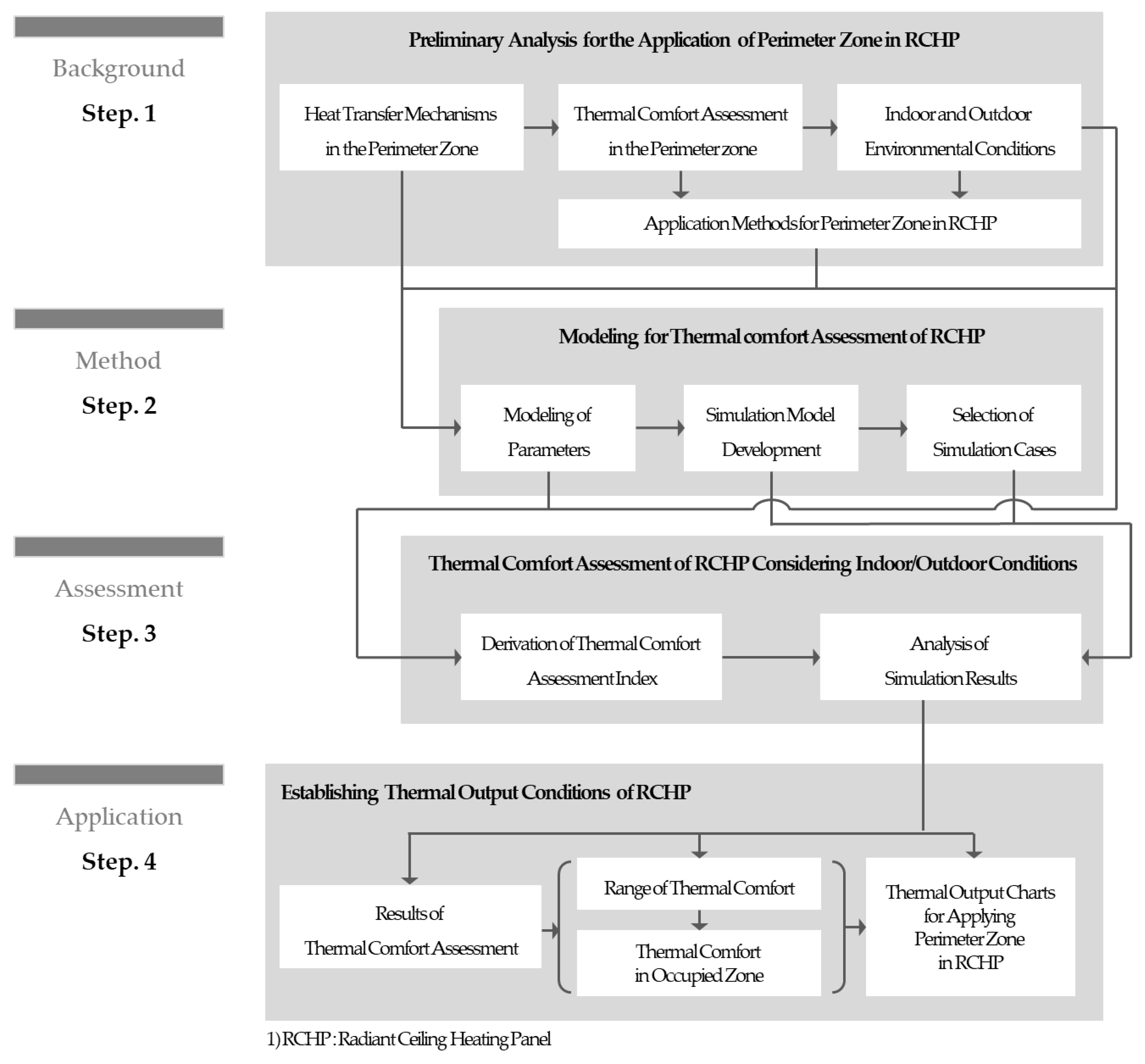
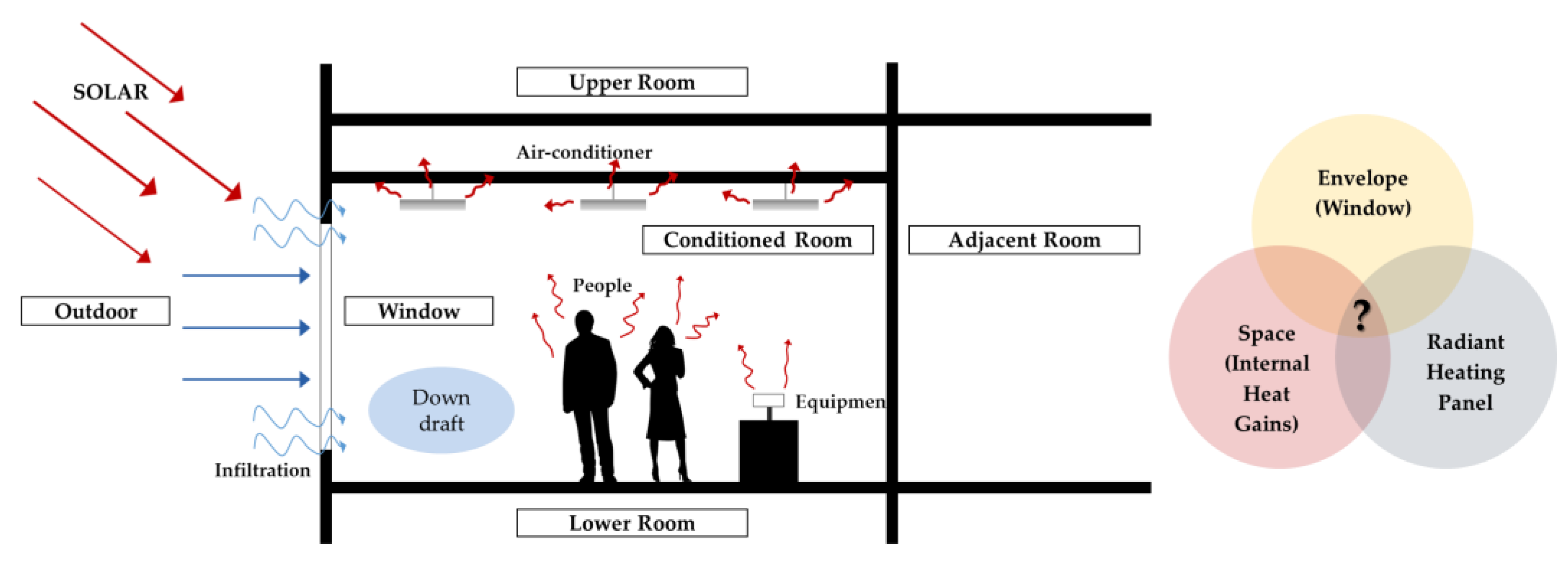
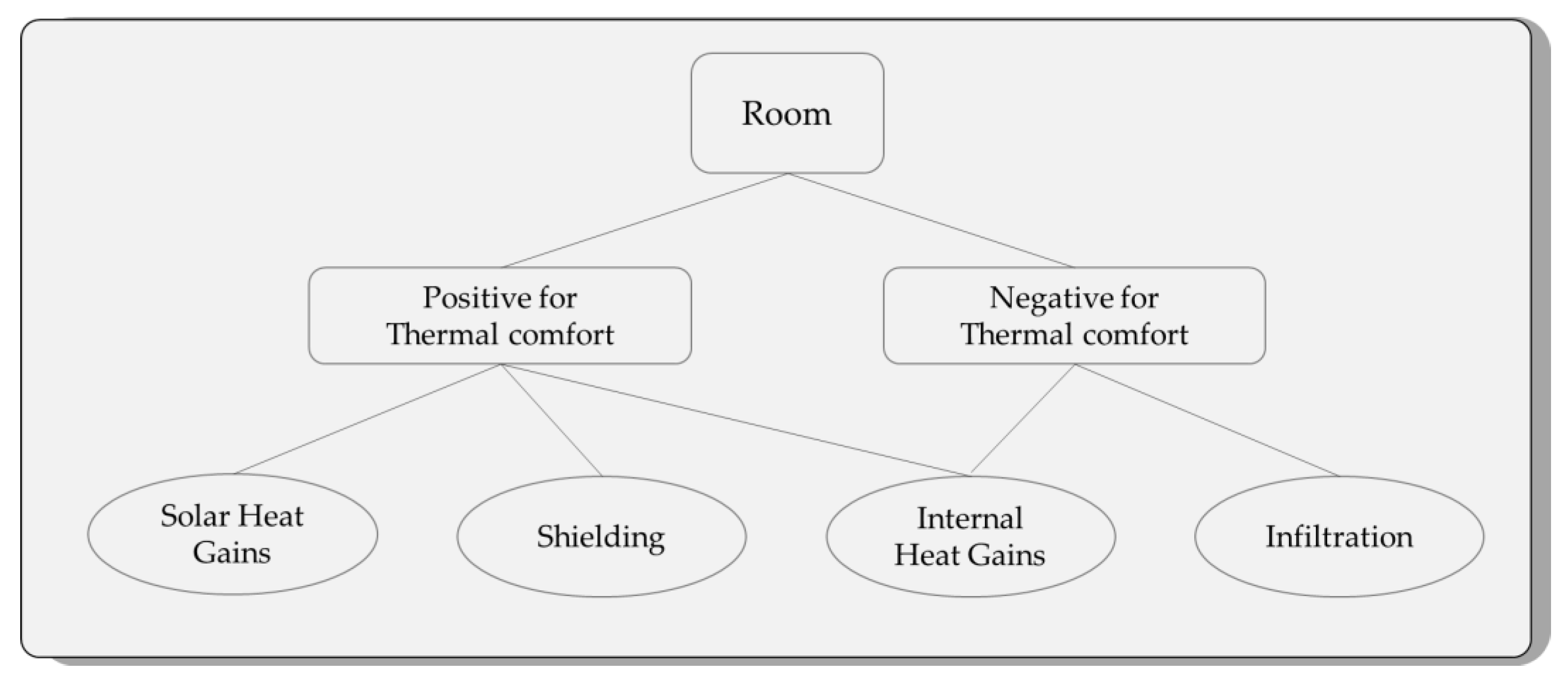
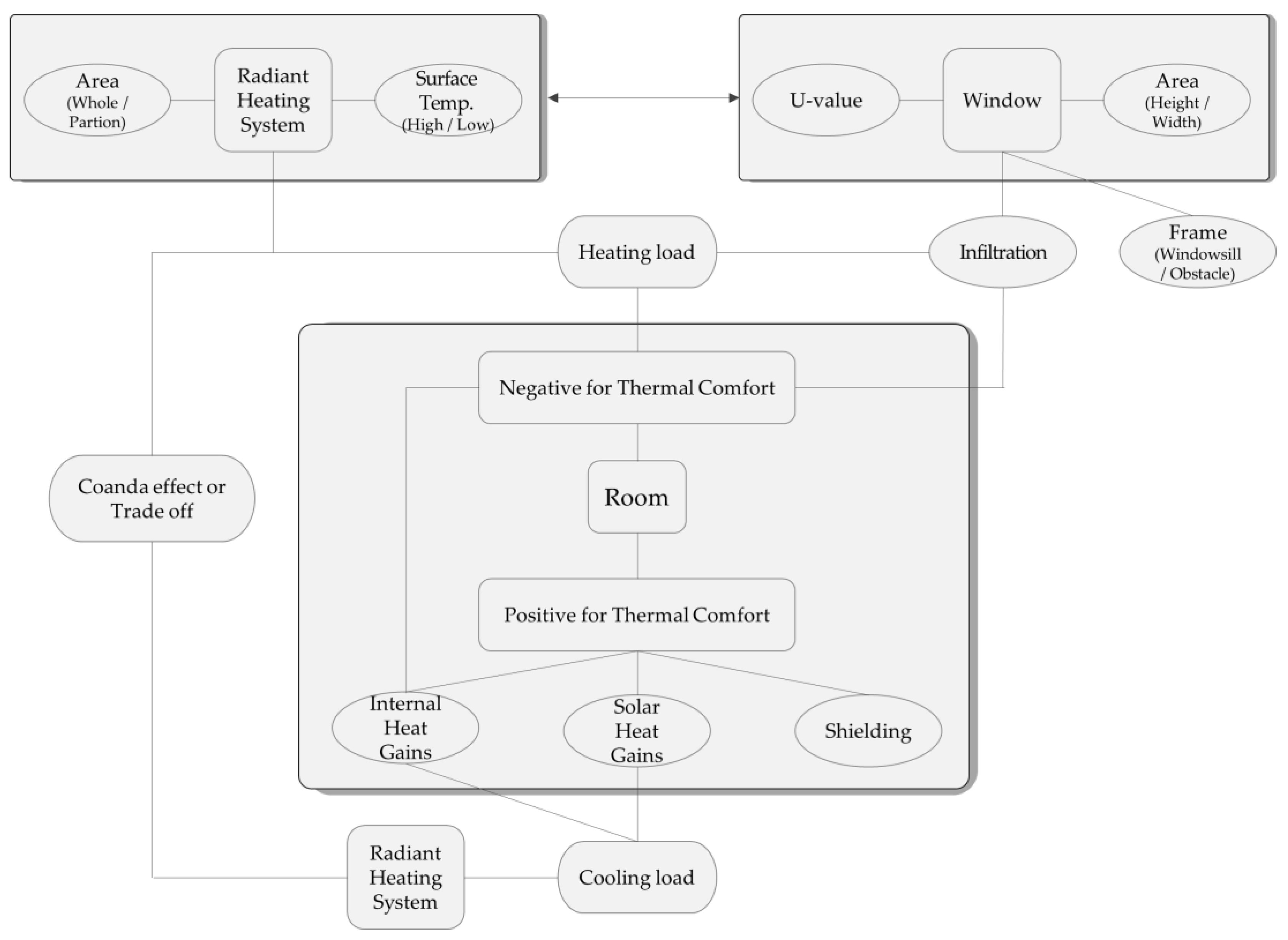
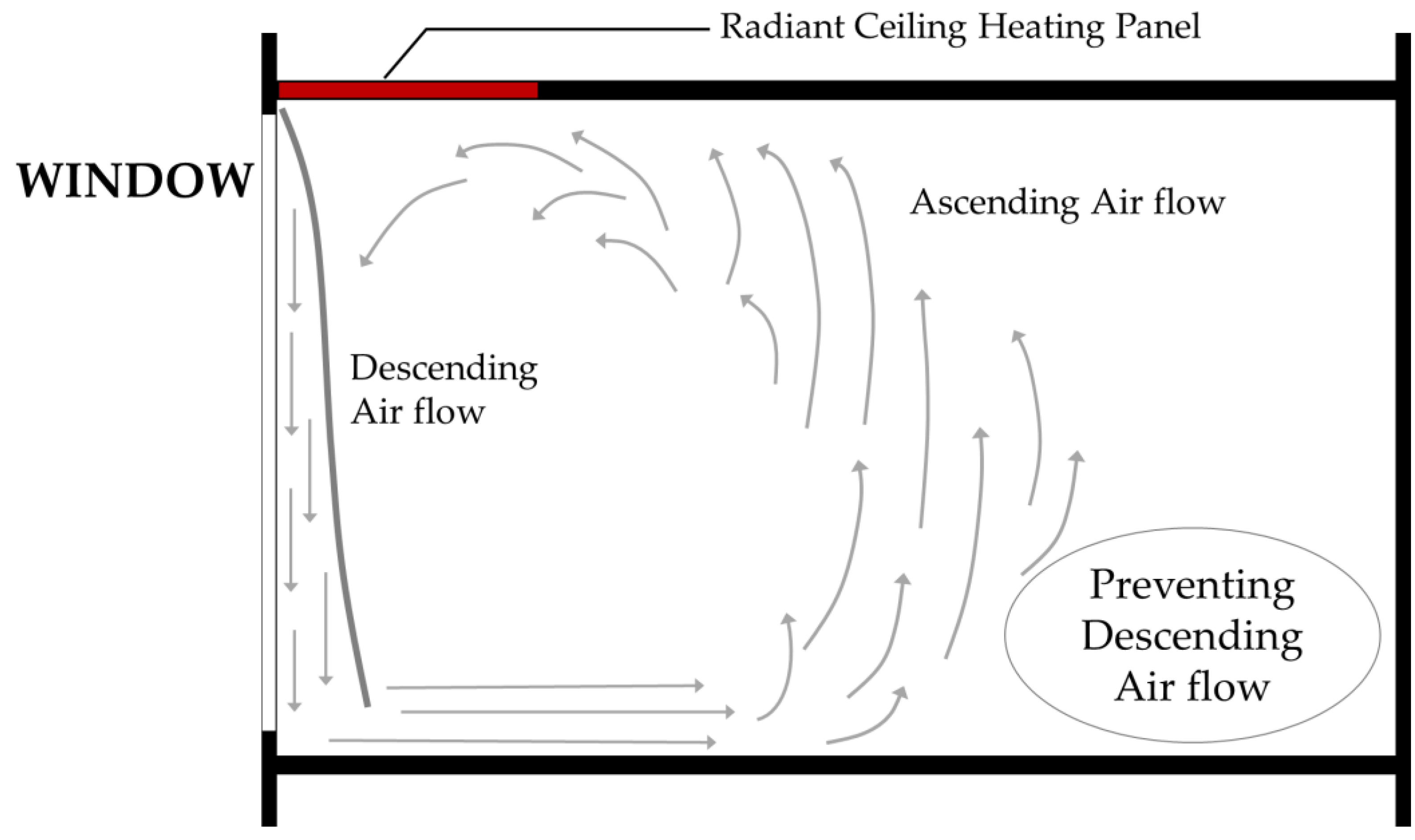
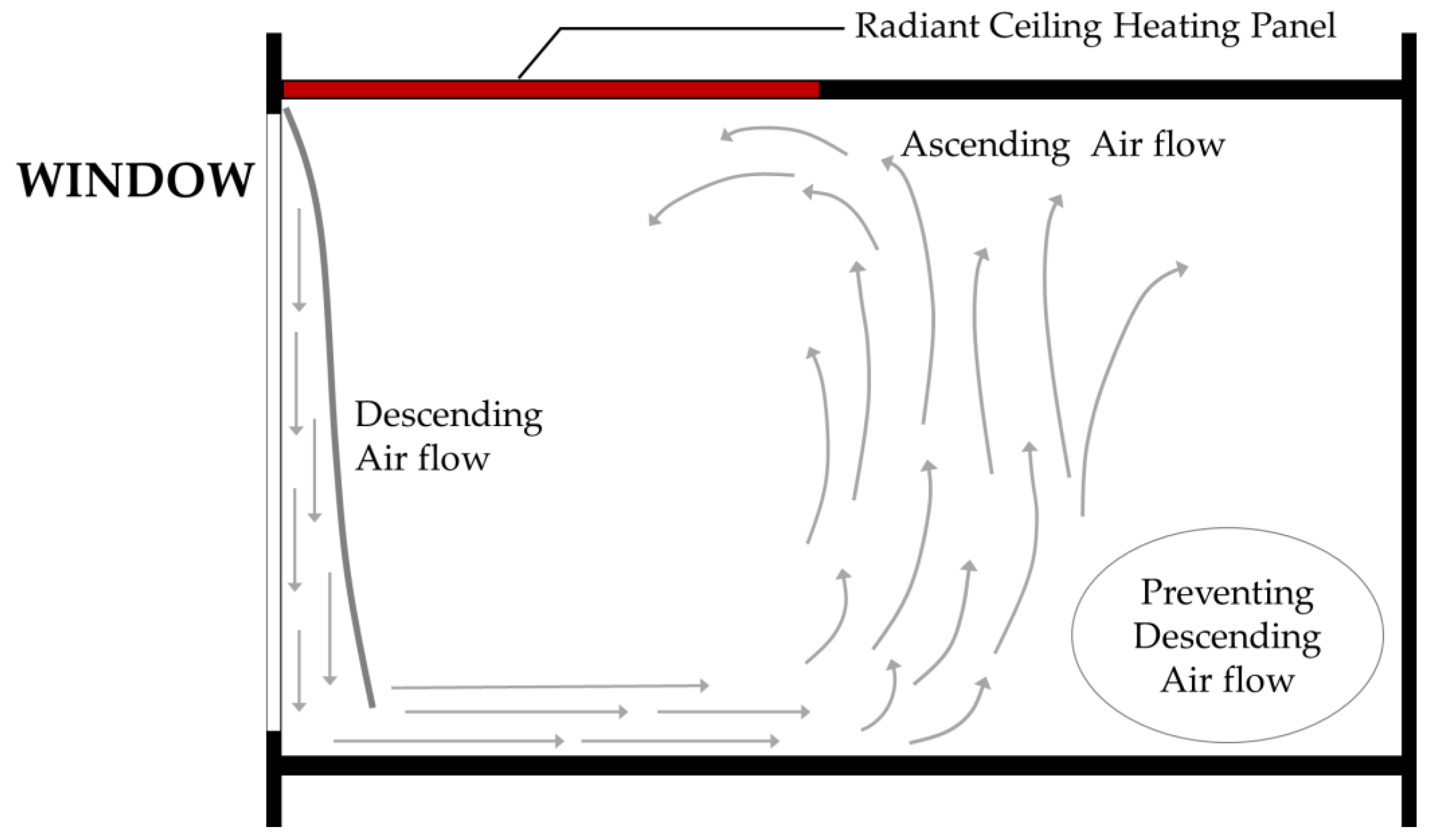
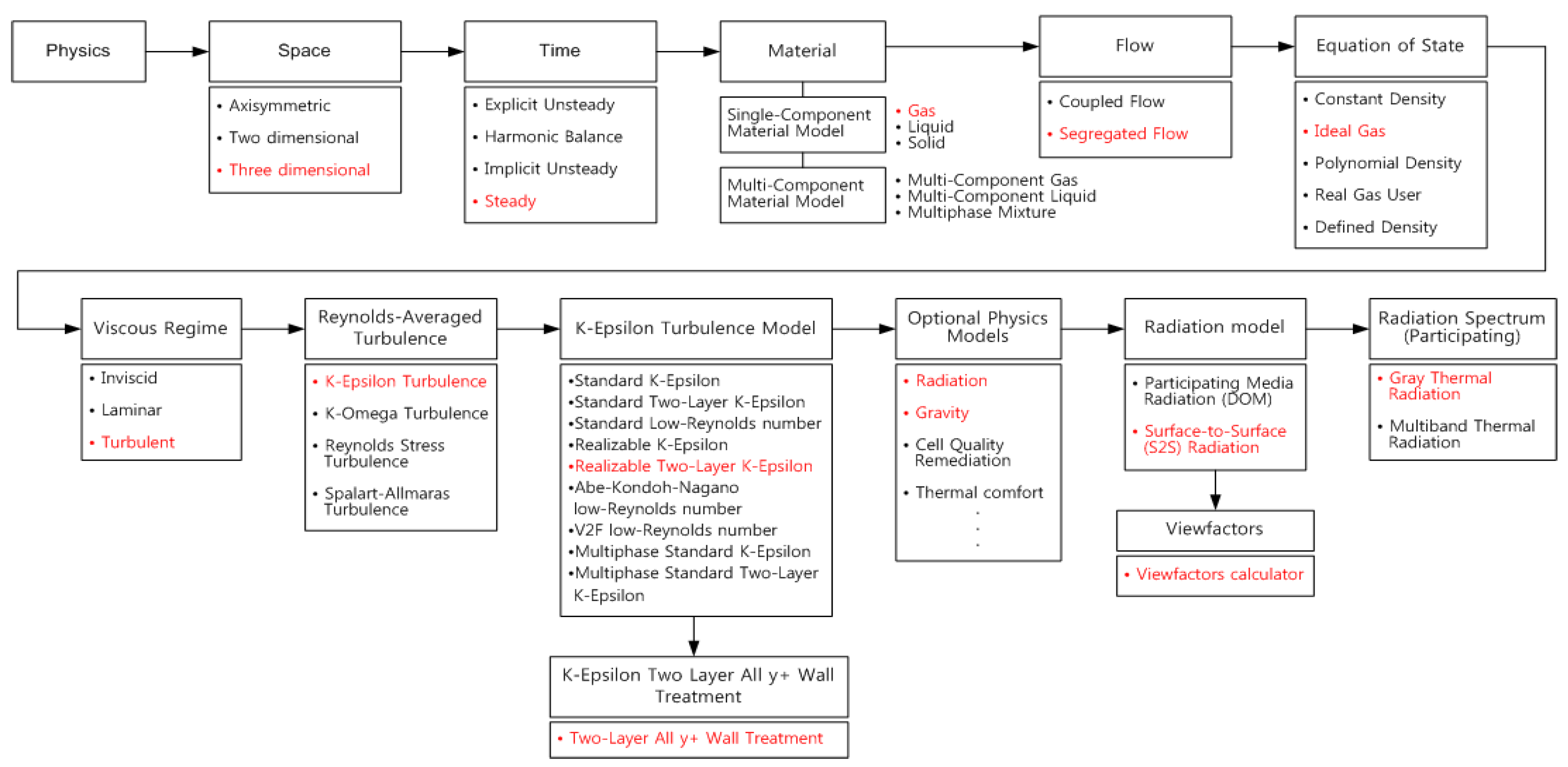
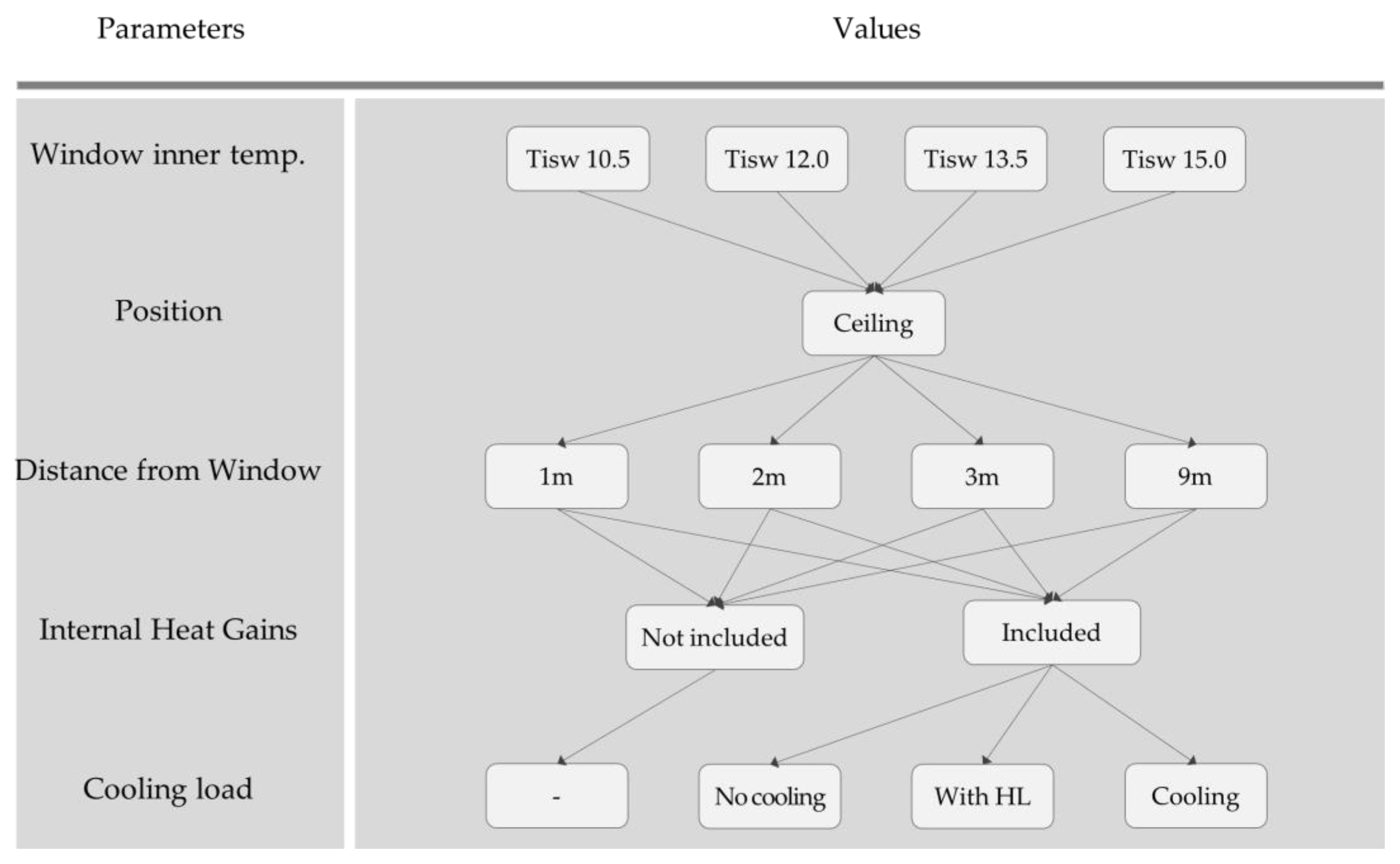
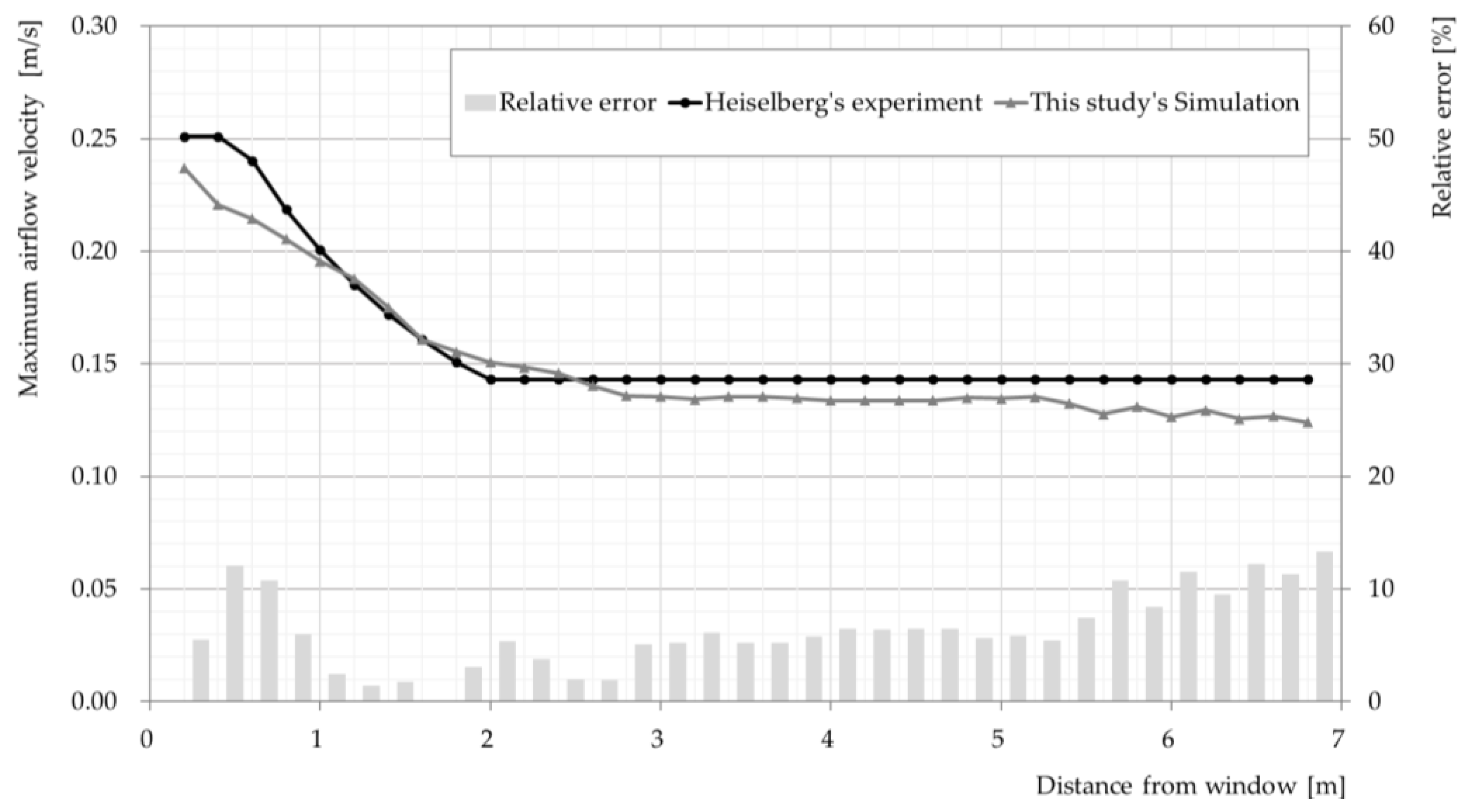

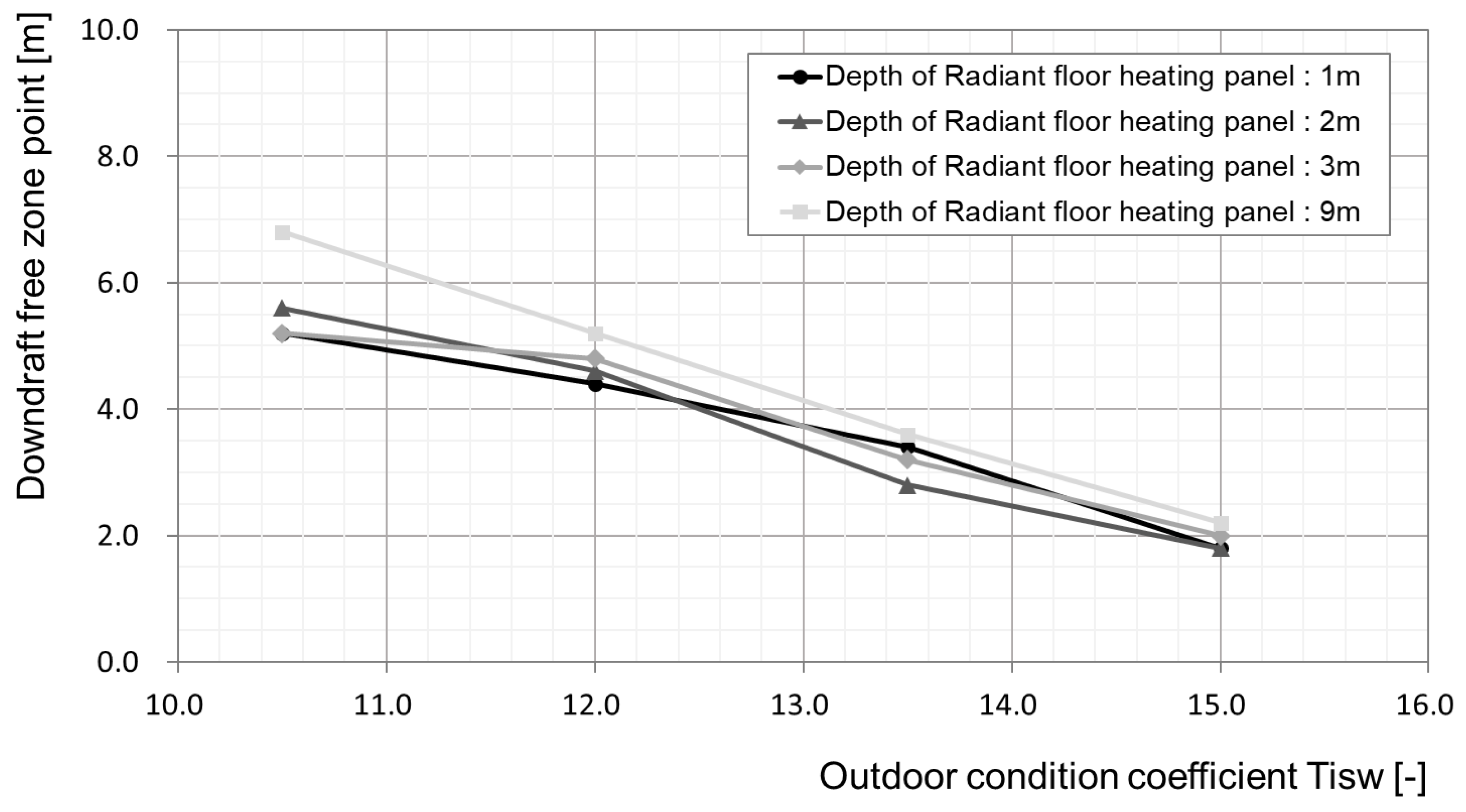
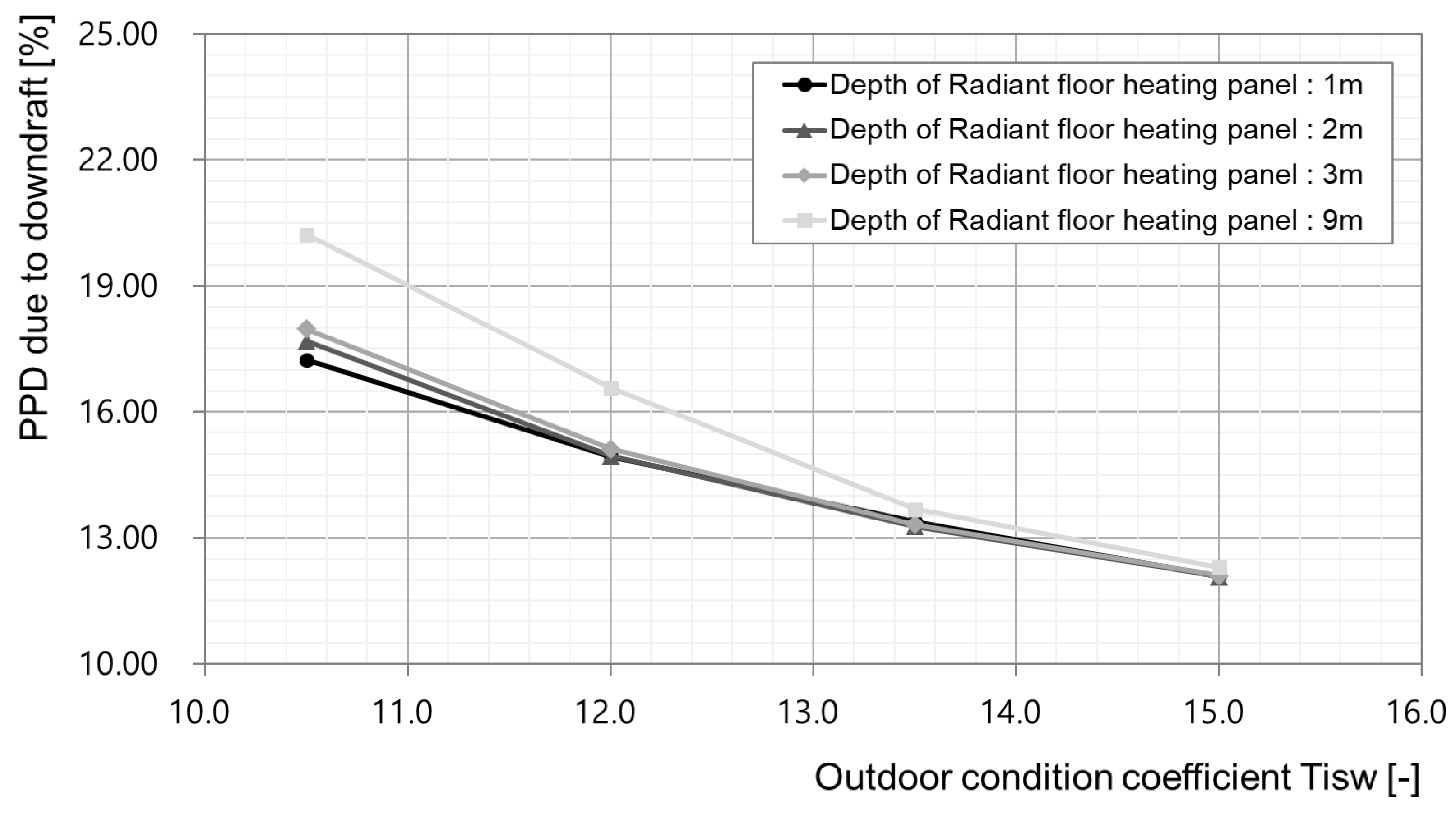
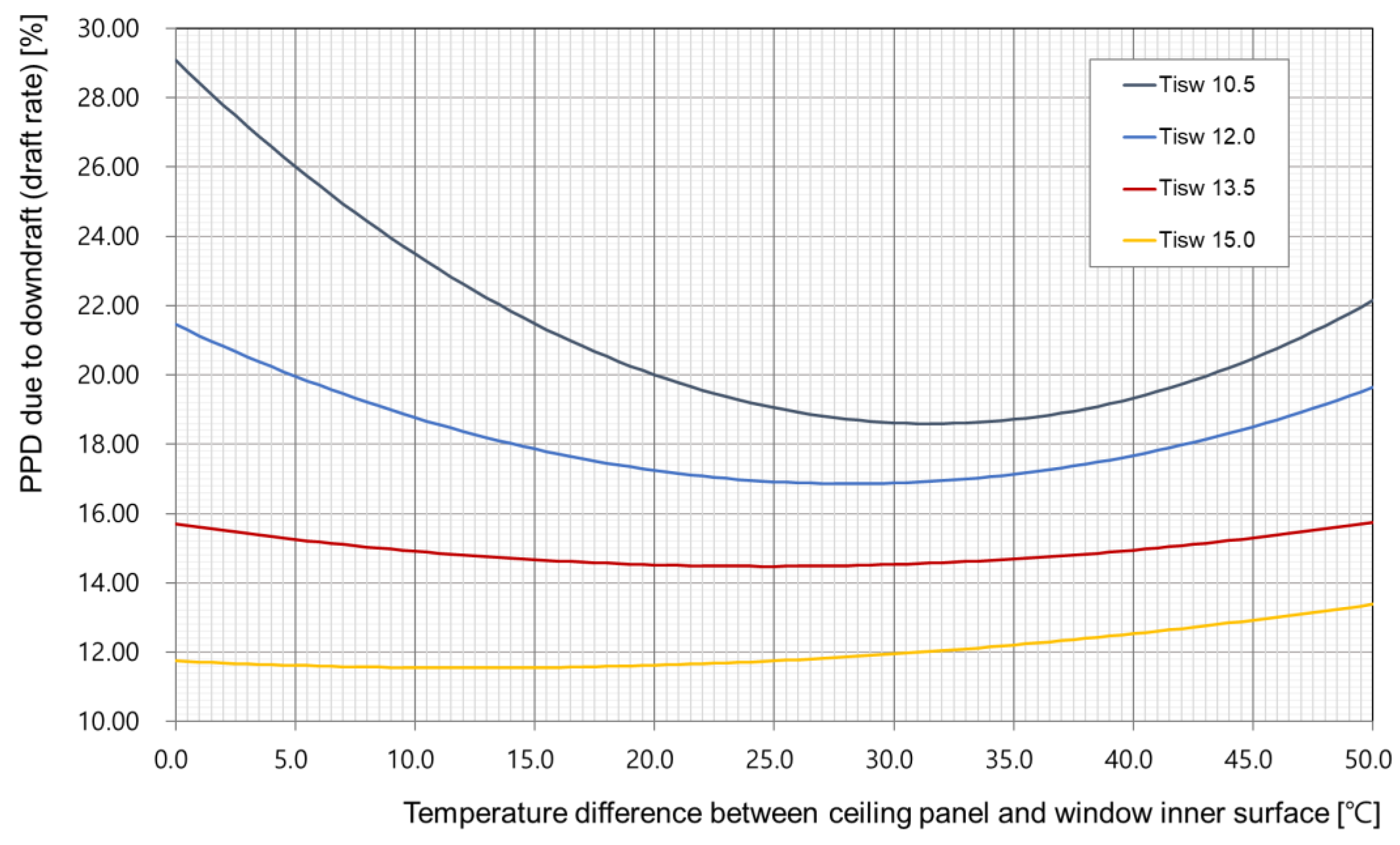
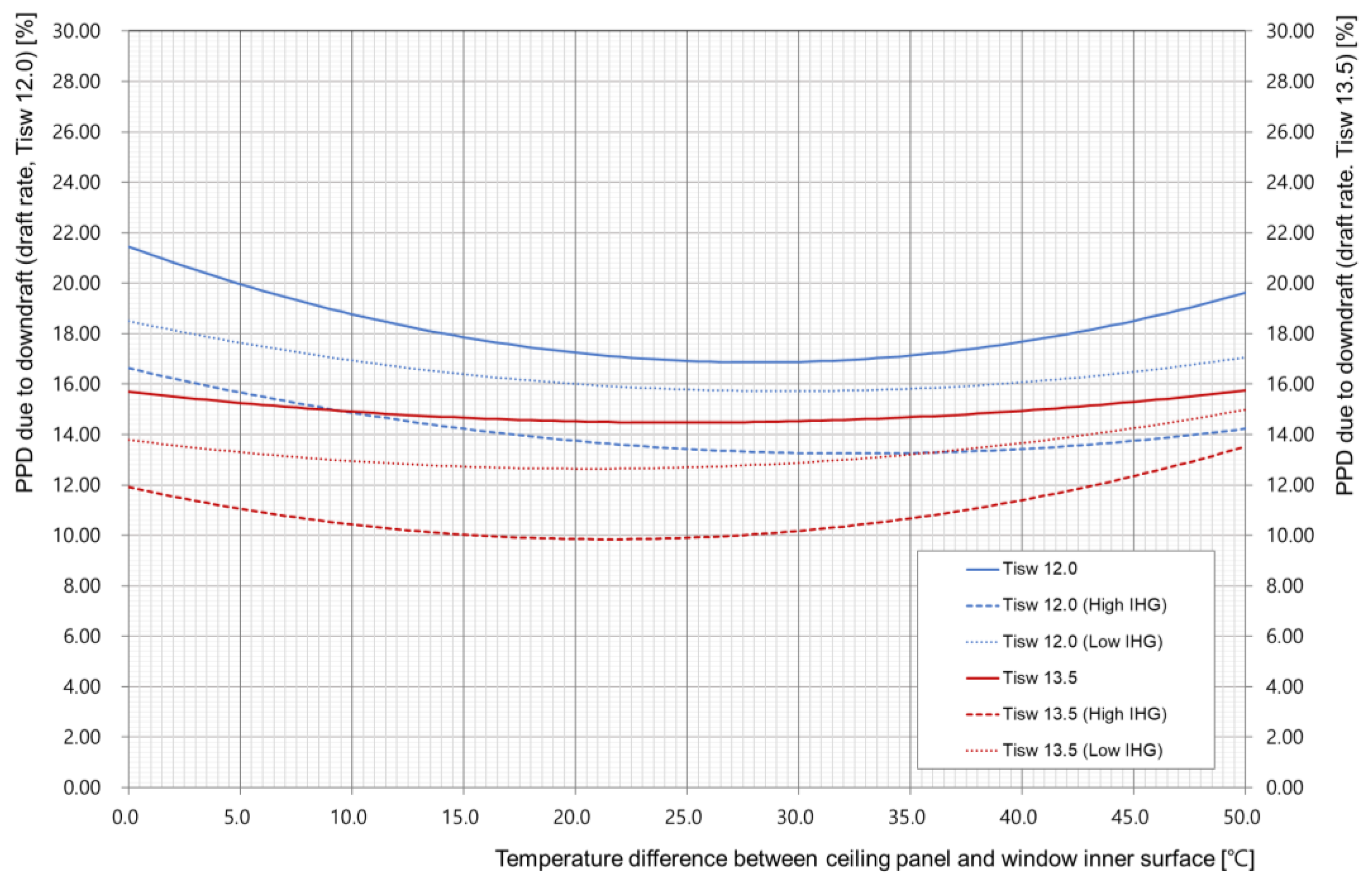
| Classification | Description |
|---|---|
| Ceiling height | 2.7 m~3.3 m |
| Depth of space | Maximum 12 m |
| Unit model (structure module by column) | 9 m × 12 m |
| Occupation density | 0.1 person/m2~0.2 person/m2 |
| Classification | Description | ||
|---|---|---|---|
| Value | Reference | ||
| People | 70 W | Seated, very light work, Sensible Heat (2021 ASHRAE Handbook) | |
| Lighting | 54.675 W | The value obtained by converting the total heat gain of lighting in the target office, which is 12 W/m2, into a value per unit area. | |
| Equipment | Computer | 95 W | Conservative value, Including monitor (2021 ASHRAE Handbook) |
| Printer | 110 W | Conservative value (2021 ASHRAE Handbook) | |
| Shape | Integrated model | 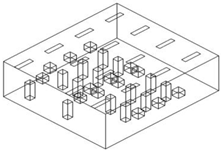 | |
| Classification | 1.75 W/m2 °C | 1.15 W/m2 °C | Index |
|---|---|---|---|
| −16.7 °C | 10.559 °C | 13.796 °C | Tisw * 10.5 |
| −11.3 °C | 11.968 °C | 14.709 °C | Tisw 12.0 |
| −5.9 °C | 13.477 °C | 15.622 °C | Tisw 13.5 |
| −0.2 °C | 14.926 °C | 16.585 °C | Tisw 15.0 |
| Case | Outdoor Conditions | Cooling Load with IHG [W] | Thermal Output Conditions | Heating Load with IHG [-] | ||
|---|---|---|---|---|---|---|
| Tisw [-] | Heating Load [W] | Heating Area [m2] | Surface Temp. [°C] | |||
| A_01 | 10.5 | 1786.25 | N/A | 8.1 (1) | 56.75 | N/A |
| A_02 | 16.2 (2) | 38.38 | ||||
| A_03 | 24.3 (3) | 32.25 | ||||
| A_04 | 72.9 (9) | 24.08 | ||||
| A_05 | 12.0 | 1332.35 | N/A | 8.1 (1) | 47.41 | |
| A_06 | 16.2 (2) | 33.71 | ||||
| A_07 | 24.3 (3) | 29.14 | ||||
| A_08 | 72.9 (9) | 23.05 | ||||
| A_09 | 13.5 | 761.25 | N/A | 8.1 (1) | 35.66 | |
| A_10 | 16.2 (2) | 27.83 | ||||
| A_11 | 24.3 (3) | 25.22 | ||||
| A_12 | 72.9 (9) | 21.74 | ||||
| A_13 | 15.0 | 510.32 | N/A | 8.1 (1) | 30.50 | |
| A_14 | 16.2 (2) | 25.25 | ||||
| A_15 | 24.3 (3) | 23.50 | ||||
| A_16 | 72.9 (9) | 21.17 | ||||
| B_01 | 12.0 | 1332.35 | 1980 | 8.1 (1) | 47.41 | |
| B_02 | 16.2 (2) | 33.71 | ||||
| B_03 | 24.3 (3) | 29.14 | ||||
| B_04 | 72.9 (9) | 23.05 | ||||
| B_05 | 13.5 | 761.25 | 8.1 (1) | 35.66 | ||
| B_06 | 16.2 (2) | 27.83 | ||||
| B_07 | 24.3 (3) | 25.22 | ||||
| B_08 | 72.9 (9) | 21.74 | ||||
| B_09 | 12.0 | 1332.35 | 1080 | 8.1 (1) | 47.41 | |
| B_10 | 16.2 (2) | 33.71 | ||||
| B_11 | 24.3 (3) | 29.14 | ||||
| B_12 | 72.9 (9) | 23.05 | ||||
| B_13 | 13.5 | 761.25 | 8.1 (1) | 35.66 | ||
| B_14 | 16.2 (2) | 27.83 | ||||
| B_15 | 24.3 (3) | 25.22 | ||||
| B_16 | 72.9 (9) | 21.74 | ||||
| C-01 | 12.0 | 1332.35 | 1080 | 8.1 (1) | 25.19 | Including |
| C-02 | 16.2 (2) | 22.60 | ||||
| C-03 | 24.3 (3) | 21.73 | ||||
| C-04 | 72.9 (9) | 20.58 | ||||
| Case | Draft Rate (1) [%] | Position (2) [m] | RAT (3) [°C] | ||
|---|---|---|---|---|---|
| H 0.1 | H 1.1 | H 0.1 | H 1.1 | ||
| A_01 | 20.89 | 20.14 | 6.0 | 5.6 | 1.28 |
| A_02 | 18.89 | 17.89 | 6.2 | 5.8 | 1.26 |
| A_03 | 19.48 | 18.58 | 6.2 | 5.8 | 1.25 |
| A_04 | 22.08 | 21.13 | 8.2 | 7.6 | 1.24 |
| A_05 | 17.19 | 16.48 | 3.4 | 3.2 | 0.95 |
| A_06 | 17.01 | 16.34 | 3.2 | 3.2 | 0.93 |
| A_07 | 17.68 | 16.71 | 3.6 | 3.4 | 0.93 |
| A_08 | 18.51 | 17.65 | 5.4 | 5.0 | 0.92 |
| A_09 | 14.48 | 13.22 | 2.2 | 2.0 | 0.44 |
| A_10 | 14.72 | 13.44 | 2.2 | 1.8 | 0.43 |
| A_11 | 14.77 | 13.88 | 2.0 | 1.4 | 0.43 |
| A_12 | 15.03 | 14.21 | 2.4 | 1.6 | 0.43 |
| A_13 | 11.55 | 10.25 | 1.2 | 1.0 | 0.25 |
| A_14 | 11.54 | 10.21 | 1.4 | 1.2 | 0.25 |
| A_15 | 11.57 | 10.47 | 1.2 | 1.2 | 0.25 |
| A_16 | 11.59 | 10.57 | 1.2 | 1.2 | 0.25 |
| B_01 | 12.27 | 11.89 | 1.8 | 1.6 | 0.89 |
| B_02 | 12.57 | 12.25 | 1.8 | 1.6 | 0.88 |
| B_03 | 12.79 | 12.33 | 1.8 | 1.8 | 0.88 |
| B_04 | 13.55 | 13.17 | 2.2 | 2.0 | 0.87 |
| B_05 | 9.89 | 9.62 | 0.8 | 0.8 | 0.37 |
| B_06 | 10.02 | 9.79 | 1.2 | 1.0 | 0.37 |
| B_07 | 10.12 | 9.88 | 1.2 | 1.0 | 0.37 |
| B_08 | 10.47 | 10.03 | 1.2 | 1.2 | 0.36 |
| B_09 | 14.55 | 14.01 | 2.2 | 2.0 | 0.88 |
| B_10 | 14.58 | 14.12 | 2.4 | 2.0 | 0.88 |
| B_11 | 14.98 | 14.56 | 2.4 | 2.2 | 0.88 |
| B_12 | 15.54 | 15.02 | 2.8 | 2.6 | 0.87 |
| B_13 | 11.75 | 11.47 | 1.8 | 1.6 | 0.37 |
| B_14 | 11.85 | 11.55 | 1.6 | 1.4 | 0.37 |
| B_15 | 11.95 | 11.63 | 1.6 | 1.6 | 0.37 |
| B_16 | 12.17 | 11.82 | 2.0 | 1.8 | 0.36 |
| C-01 | 22.78 | 22.42 | 2.8 | 2.6 | 0.26 |
| C-02 | 22.45 | 22.32 | 2.8 | 2.4 | 0.27 |
| C-03 | 22.98 | 22.85 | 3.0 | 2.6 | 0.27 |
| C-04 | 25.25 | 24.98 | 4.4 | 4.0 | 0.28 |
Disclaimer/Publisher’s Note: The statements, opinions and data contained in all publications are solely those of the individual author(s) and contributor(s) and not of MDPI and/or the editor(s). MDPI and/or the editor(s) disclaim responsibility for any injury to people or property resulting from any ideas, methods, instructions or products referred to in the content. |
© 2023 by the authors. Licensee MDPI, Basel, Switzerland. This article is an open access article distributed under the terms and conditions of the Creative Commons Attribution (CC BY) license (https://creativecommons.org/licenses/by/4.0/).
Share and Cite
Joe, G.; Park, S. A Study on Establishing Thermal Output Conditions of Radiant Ceiling Heating Panels for Improving Thermal Comfort of Perimeter Zone in Buildings. Appl. Sci. 2023, 13, 6744. https://doi.org/10.3390/app13116744
Joe G, Park S. A Study on Establishing Thermal Output Conditions of Radiant Ceiling Heating Panels for Improving Thermal Comfort of Perimeter Zone in Buildings. Applied Sciences. 2023; 13(11):6744. https://doi.org/10.3390/app13116744
Chicago/Turabian StyleJoe, Goosang, and Sanghoon Park. 2023. "A Study on Establishing Thermal Output Conditions of Radiant Ceiling Heating Panels for Improving Thermal Comfort of Perimeter Zone in Buildings" Applied Sciences 13, no. 11: 6744. https://doi.org/10.3390/app13116744
APA StyleJoe, G., & Park, S. (2023). A Study on Establishing Thermal Output Conditions of Radiant Ceiling Heating Panels for Improving Thermal Comfort of Perimeter Zone in Buildings. Applied Sciences, 13(11), 6744. https://doi.org/10.3390/app13116744





